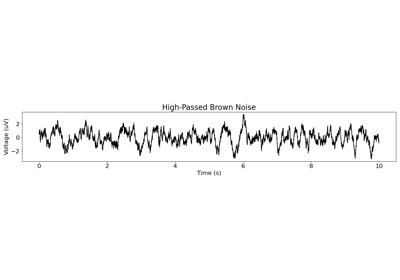neurodsp.sim.sim_random_walk¶
- neurodsp.sim.sim_random_walk(n_seconds, fs, theta=1.0, mu=0.0, sigma=5.0, norm=True)[source]¶
Simulate a mean-reverting random walk, as an Ornstein-Uhlenbeck process.
- Parameters:
- n_secondsfloat
Simulation time, in seconds.
- fsfloat
Sampling rate of simulated signal, in Hz.
- thetafloat, optional, default: 1.0
Memory scale parameter. Larger theta values create faster fluctuations.
- mufloat, optional, default: 0.0
Mean of the random walk.
- sigmafloat, optional, default: 5.0
Scaling of the Wiener process (dWt).
- normbool, optional, default: True
Whether to normalize the signal to the mean (mu) and variance ((sigma**2 / (2 * theta))).
- Returns:
- sig1d array
Simulated random walk signal.
Notes
The random walk is simulated as a discretized Ornstein-Uhlenbeck process:
dx = theta*(x-mu)*dt + sigma*dWt
Where:
mu : mean
sigma : Wiener scaling
theta : memory scale
dWt : increments of Wiener process, i.e. white noise
The Wiener scaling (sigma) differs from the standard deviation of the signal. The standard deviation of the signal will instead equal: sigma / np.sqrt(2 * theta).
See the wikipedia page [1] for the integral solution.
References
Examples
Simulate a Ornstein-Uhlenbeck random walk:
>>> sig = sim_random_walk(n_seconds=1, fs=500, theta=1.)
